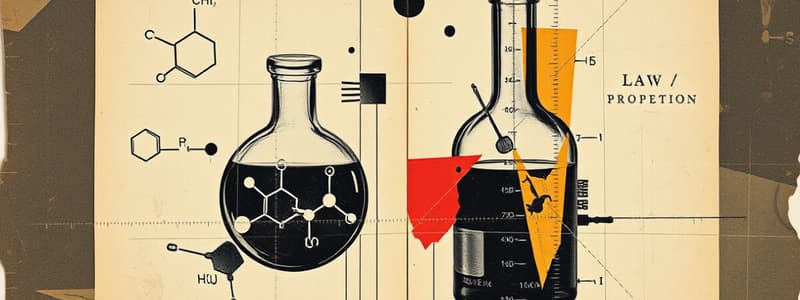Podcast
Questions and Answers
What is the law of definite proportions?
What is the law of definite proportions?
It states that a given chemical compound always contains the same elements in the exact same proportions by mass.
A given chemical compound always contains the same elements in the exact same proportions by mass is the law of _____
A given chemical compound always contains the same elements in the exact same proportions by mass is the law of _____
definite proportions
Identify the law that explains the following observation: Nitrogen dioxide can be formed by reacting 14 grams of nitrogen with 32 grams of oxygen.
Identify the law that explains the following observation: Nitrogen dioxide can be formed by reacting 14 grams of nitrogen with 32 grams of oxygen.
the law of definite proportions
What mass of hydrogen is contained in Lake Superior if it contains about 1.2×10^16 kg of water and is 11.19% hydrogen?
What mass of hydrogen is contained in Lake Superior if it contains about 1.2×10^16 kg of water and is 11.19% hydrogen?
What is the percent by mass of chlorine in table salt (NaCl) if the percent by mass of sodium is 39.34 %?
What is the percent by mass of chlorine in table salt (NaCl) if the percent by mass of sodium is 39.34 %?
A chemical compound is always found to be made up of the same elements combined together in the same fixed proportion by mass. This is known as the:
A chemical compound is always found to be made up of the same elements combined together in the same fixed proportion by mass. This is known as the:
A chemical compound is always found to be made up of the same elements combined together in different proportions by mass.
A chemical compound is always found to be made up of the same elements combined together in different proportions by mass.
Will the composition of water vary depending on its source?
Will the composition of water vary depending on its source?
In carbon dioxide, 12 grams of carbon combines with 16 grams of oxygen.
In carbon dioxide, 12 grams of carbon combines with 16 grams of oxygen.
The law of definite proportions is only applicable when the elements which are reacting together form the same product.
The law of definite proportions is only applicable when the elements which are reacting together form the same product.
Every molecule of carbon dioxide consists of 1 atom(s) of carbon and 2 atom(s) of oxygen.
Every molecule of carbon dioxide consists of 1 atom(s) of carbon and 2 atom(s) of oxygen.
A chemical compound is always found to be made up of the same elements combined together in the same fixed proportion by mass. This is known as the:
A chemical compound is always found to be made up of the same elements combined together in the same fixed proportion by mass. This is known as the:
Flashcards are hidden until you start studying
Study Notes
Law of Definite Proportions
- The law states that a specific chemical compound contains its constituent elements in a fixed ratio by mass.
- This principle ensures uniformity in the composition of compounds regardless of their source or preparation method.
Conceptual Understanding
- Nitrogen dioxide formation by reacting 14 grams of nitrogen with 32 grams of oxygen exemplifies the law, indicating consistent proportions in compounds.
- Water has a definite composition of 11.19% hydrogen and 88.81% oxygen by mass, reinforcing the notion of fixed proportions.
Calculations and Percentages
- Lake Superior, containing approximately 1.2×10^16 kg of water, would have about 1.3×10^15 kg of hydrogen.
- In table salt (NaCl), sodium constitutes 39.34% by mass, leading to chlorine making up the remaining 60.66%.
Validating the Law
- A compound's elements are always combined in the same proportions by mass, affirming the law's definition.
- Compounds don't vary in composition based on their source, as illustrated by water.
Common Misconceptions
- A statement claiming a chemical compound can be formed from varying proportions by mass is incorrect; fixed proportions are essential for defining a compound.
- It’s a misconception that the composition of water can differ depending on its source—it remains constant.
True or False Statements
- Statements affirming that carbon dioxide comprises one carbon atom and two oxygen atoms are true, reflecting the definitive elemental makeup.
- The assertion that the law applies only when elements yield identical products is correct; the law holds true in such cases.
Studying That Suits You
Use AI to generate personalized quizzes and flashcards to suit your learning preferences.




